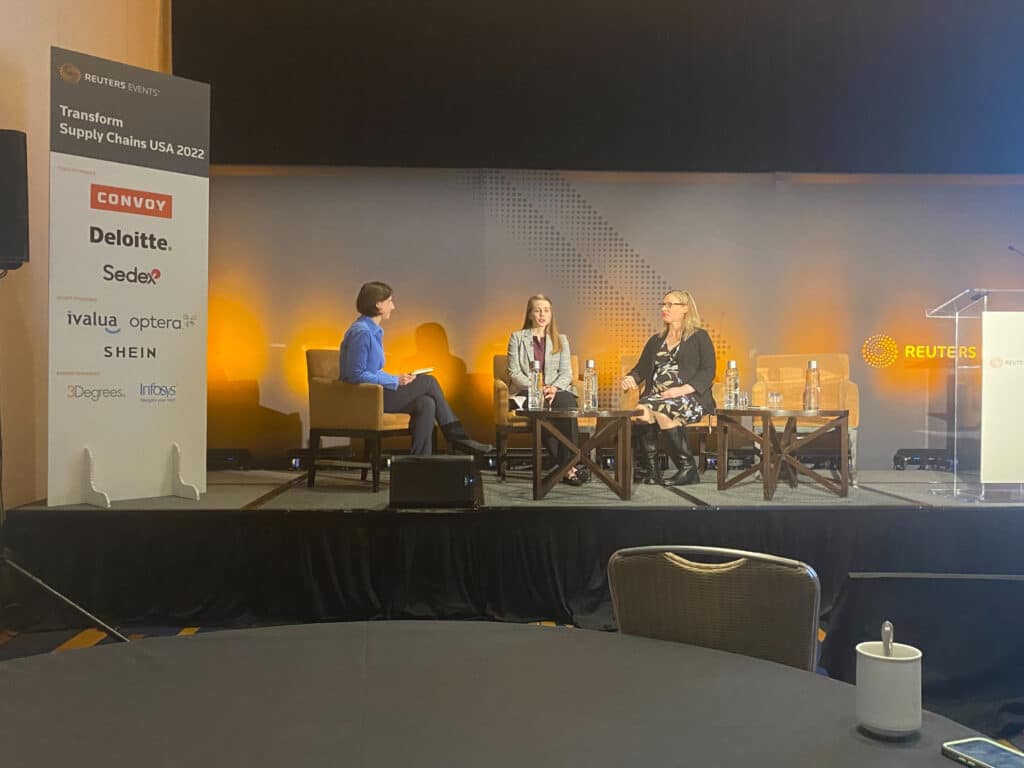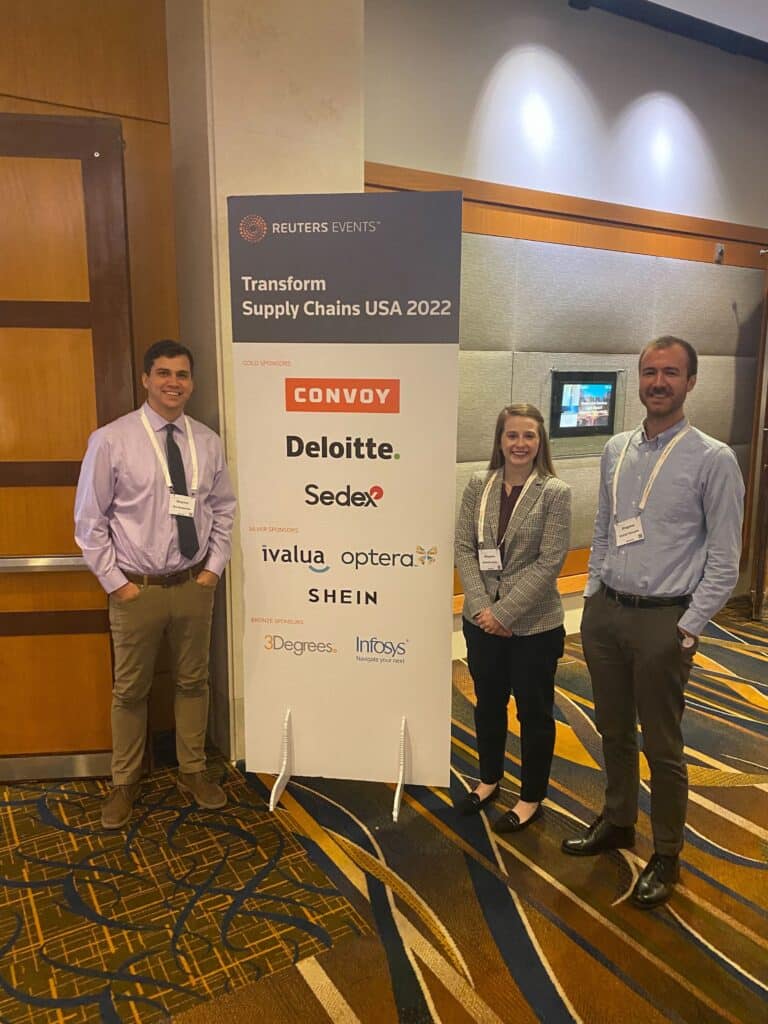At nearly every conference that we have attended this year, our teams have heard about the complexities surrounding quantifying and addressing supply chain emissions. As we know supply chain emissions account for the lion’s share of a company’s total emissions (upwards of 90% in some cases), it was satisfying to attend an entire conference devoted to this topic. At the Reuters Transform Supply Chains USA conference, we dug into this very complicated challenge, shared learnings, and identified opportunities to better quantify and reduce emissions throughout the supply chain.
The first-ever Reuters Transform Supply Chains USA was held in Chicago and brought together over 250 supply chain and sustainability experts to explore cutting-edge methods for decarbonizing entire value chains across all sectors. Alongside two of my fellow colleagues, I journeyed to the Windy City to join in on the discussion. In two days time, we emerged with new potential partnerships, industry connections, and strategies to influence our teams’ efforts. Read along for a deep dive on the major themes we picked up on at the event.
Combatting Scope 3

ECP Director, Elizabeth Geller, participated in a panel on day two of Reuters Transform Supply Chains USA.
At the conference, I had the pleasure of participating in a panel titled “Decarbonizing the Supply Chain: Combatting the Challenge of Scope 3 Emissions” next to Chief Sustainability Officer of Conagra Brands, Katya Hantel. Our discussion centered around two main challenges of scope 3 emissions: how they are quantified and how they are reduced.
I stressed that scope 3 emissions quantification and hot spot analysis is an iterative process – companies can start measuring emissions in a variety of ways, including the use of economic input-output tools, industry-wide emission factors, and supplier engagement. The key is to get started. We also discussed some of the drivers of action around addressing scope 3 emissions. Regulatory and investor pressure are motivators necessitating the collection of quantifiable, comprehensive data from all scopes of the supply chain. It’s becoming increasingly critical to leverage tools and frameworks to help organizations feel more confident in their emissions data.
There were nods to existing data collection platforms such as Ecovadis and the Sustainable Apparel Coalition’s Higg Index, which are widely used across the industry for access to supplier sustainability data, and discussion about new emission quantification platforms as well. There is excitement around the ability of climate management platforms to enhance data collection and improve the reliability, accuracy, and availability of scope 3 measurements. That being said, human-powered analysis from energy and climate professionals is essential to ensure these new and existing tools are being used accurately, help fill the data gaps, interpret highly technical emission factors, and apply the findings to organizations’ unique supply chains.
Our partnership with multiple climate tech software platforms makes GHG emission reduction services more accessible, across all three scopes of emissions. These platforms’ joint services provide granular emissions data, a precise understanding of each scope, and streamlined GHG emissions reporting. In addition to our partnerships, we also assist organizations in the selection of a climate tech software solution that works best for them. In studying the ecosystem of leading software solutions, we look for a number of foundational requirements, including integrations, market positioning, audit-ability, and emissions reduction planning.
With over 100 climate-related software solutions to optimize the accounting and reporting process, it is challenging to know which to select and where to begin. We can assist in exploring available tools, making a best-fit selection, and then onboarding the right piece of technology for your business.
Looking beyond emission quantification, another important topic that I discussed during the panel was scope 3 emission reduction strategy. Organizations looking at getting started on scope 3 emissions reductions can consider the following four strategies:
- Internal policy innovation (e.g. business travel policies)
- Product design innovation (e.g. making design changes to reduce emissions from customer product use)
- Customer engagement (e.g. buy-back programs)
- Supplier engagement (e.g. educating suppliers on renewable energy procurement or other emission reduction projects)

The 3Degrees team at Reuters Transform Supply Chains USA Conference in Chicago.
Supplier Engagement
Supplier engagement strategies were a recurring theme at the conference. Corporates are mostly engaging with tier 1 (those that supply the company directly) and tier 2 (direct suppliers to their tier 1) suppliers, and that traceability down to the lower tier suppliers will likely become a requirement in coming years. Effective supplier engagement programs are typically geared toward suppliers with a high emissions impact or those that make up a sizable portion of the company’s spend. Many organizations discussed feedback received from their suppliers, which uncovered a need for uniformity in requesting supply chain data and support in providing emission reduction strategies.
Across industries, supplier energy usage is a major scope 3 hotspot and a tangible area for supplier engagement. It’s important to understand how much electricity suppliers use to manufacture purchased products and the grid emission factor for that region. In addressing this area of emissions, companies can provide suppliers with educational materials for quantifying emissions, setting science-based targets, and procuring renewable energy that is available locally.
Another supplier engagement starting point discussed at the conference was related to companies that purchase animal products. Suppliers of beef or dairy can reduce emissions by changing manure management practices to reduce methane or changing grazing practices to increase soil carbon sequestration. Approaches such as these can significantly reduce supplier operational emissions and ultimately result in a revised supplier-specific emission factor for the sourcing brand. Our Carbon Markets team works with farms and ranchers on the ground to set up projects, monitor progress, and help brands with claims guidance surrounding the projects’ emissions reductions.
How We Help
There is a reason scope 3 gets a lot of attention—it is the least understood source of emissions and the most challenging to address. Despite this, organizations shouldn’t be afraid to dig into this portion of their business’ operational activity. 3Degrees can help your organization calculate a greenhouse gas emissions inventory, select a greenhouse gas emissions quantification software, manage scope 3 data, design a supplier engagement strategy that’s right for your organization, and engage with suppliers to reduce emissions in your supply chain.
If you’re interested in better understanding your organization’s scope 3 footprint, or for guidance in the complex process of greenhouse gas reduction, please get in touch today.

